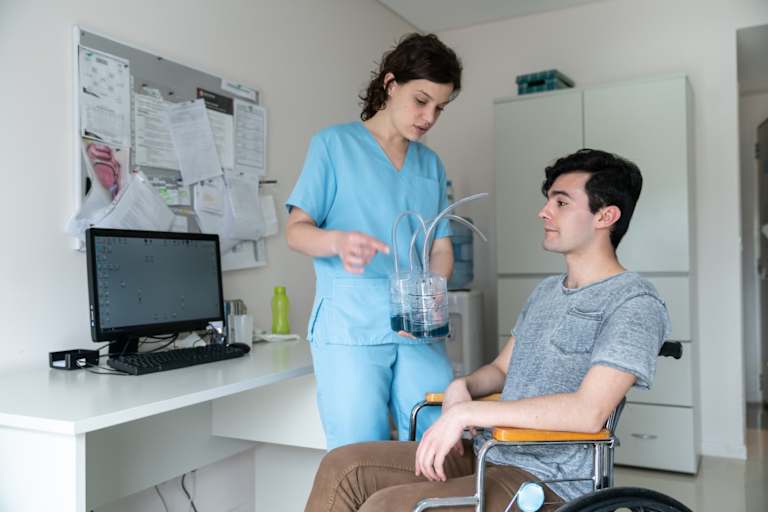How to Become a Respiratory Therapist
Portions of the following article were drafted using an in-house natural language generation platform. The article was then reviewed, fact-checked, and edited by multiple members of our editorial team prior to publishing.
- Respiratory therapists typically need an associate degree, but some employers prefer candidates with bachelor’s degrees.
- Respiratory therapists need state licensure in every state except Alaska.
- Getting state licensure involves completing the necessary education and passing the national board exam.
Interested in a career in healthcare but don’t want to spend several years in school? Consider becoming a respiratory therapist (RT). With a median annual wage of $70,540 and a projected job growth rate of 13% from 2022-2032, according to the Bureau of Labor Statistics (BLS), respiratory therapy offers a promising career path that requires only an associate degree and a state license.
In this article, we’ll explore the steps to becoming a respiratory therapist, including the option to earn a bachelor’s degree in this field. If you’re ready to embark on a fulfilling and in-demand career, here’s how to become a respiratory therapist.
5 Steps to Become a Respiratory Therapist
Wondering how to become a respiratory therapist? Follow these five essential steps to kickstart your career:
Step 1: Obtain Your High School Diploma or GED Certificate
The first step to becoming a respiratory therapist is getting your high school diploma or GED certificate. Take as many math and science subjects as you can, as they form the foundation for your future coursework in respiratory care.
Step 2: Earn an Associate Degree in Respiratory Therapy
After high school, the next step is to earn an associate degree in respiratory therapy from an accredited program. This two-year degree forms the basic requirement to become a Certified Respiratory Therapist (CRT).
Associate degree programs cover essential subjects such as airway management, mechanical ventilation, and medical gas therapies to help you understand the foundations of respiratory therapy.
Step 3: Pass the National Credentialing Exam
Once you’ve earned your degree, it’s time to take the Therapist Multiple-Choice (TMC) Examination. This exam, administered by the National Board for Respiratory Care (NBRC), assesses your ability to interpret patient data and recommend suitable procedures.
Passing this exam earns you the CRT credential. Successfully earning the CRT title is a testament to your competency and readiness to earn licensure and step into the professional world of respiratory care.
Step 4: Acquire the RRT Credential
Earn the Registered Respiratory Therapist (RRT) credential to unlock more job opportunities and increase your earning potential. This professional certification is a clear demonstration of advanced knowledge and expertise in the field of respiratory care. While not required in all states, many employers only hire candidates with the RRT credential (in addition to the CRT).
The following states require all licensed respiratory therapists to have the RRT credential: Arizona, California, New Jersey, New Mexico, Ohio, Oregon, Washington, and West Virginia.
To earn the RRT credential, you must pass the TMC credentialing exam with a high score, making you eligible to sit for the Clinical Simulation Examination (CSE). Successfully passing the CSE exam will qualify you for the RRT credential.
Step 5: Obtain State Licensure
With both your CRT and RRT credentials, you’re almost ready to practice. The next step is to apply for and obtain a state license. RTs must obtain licensure in all states except Alaska. While requirements vary, most states require an accredited associate degree in respiratory care, a certain number of clinical hours, and the CRT or RRT credential.
Some states also require a law and professional ethics course. Always check the specific requirements in your desired state of practice.
Step 6 (Optional): Earn a Bachelor’s Degree
While not a requirement in most states, earning a bachelor’s degree in respiratory therapy can open doors to more advanced positions and higher salaries. This step is particularly beneficial if you’re interested in roles involving education, management, and clinical specialization.
With promising job growth and attractive salary prospects, a bachelor’s degree can significantly propel your career. Some employers also prefer to hire candidates with bachelor’s degrees.
What Does Respiratory Therapist Training Look Like?
Respiratory therapist training involves a combination of academic and clinical education. Associate programs blend theory-focused, classroom-based coursework with hands-on, practical experiences in the field.
You’ll cover subjects such as clinical respiratory care, medical gas therapies, and mechanical ventilation. You’ll also be required to complete fieldwork or an internship in a medical facility under the supervision of a licensed respiratory therapist.
This hands-on experience is invaluable for gaining real-world experience and refining your practical skills. Upon graduation, you’ll be prepared to sit for the NBRC exams, a significant step in becoming a respiratory therapist.
How Long Does It Take to Become a Respiratory Therapist?
So, how long does it take to become a respiratory therapist? Generally, it takes about two years to earn an associate degree, the minimum requirement to become a CRT. After that, obtaining your CRT or RRT credentials and state license can take several months. All told, you can expect to start your career as a respiratory therapist in 2-3 years.
If you choose to pursue a bachelor’s degree, you can anticipate an additional two years of study.
Frequently Asked Questions About How to Become a Respiratory Therapist
Respiratory therapy can be a challenging job, as it involves physically demanding tasks, exposure to sick patients, as well as the stress of handling life-threatening situations.
While all of these factors are a very real part of the job, working as an RT can be a rewarding career, too. Having a passion for healthcare and a desire to make a difference in patients’ lives may help alleviate some of the drawbacks of the job.



